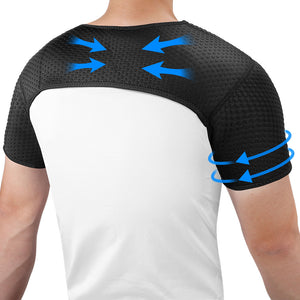How to Correct Back Posture in Daily Life: Medical Back Brace for Posture

Poor back posture not only affects the overall well-being of our body but also makes us less active. It ultimately affects how we feel about ourselves.
On the other hand, good posture helps our body to develop flexibility, strength, and balance. Studies[1] have shown that good posture reduces stress on our ligaments and muscles, reducing the risk of injury.
Ready to learn how bad posture can ruin health putting you at high risk of many health issues and how we can avoid them by correcting our back posture with the medical back brace for posture? Read this article, and at the end, you’ll know exactly how to correct back posture.

Prevalence of Poor Back Posture
To our surprise, more than 31 million Americans suffer from bad posture. Poor posture may result in many health conditions, such as back pains, spinal dysfunction, respiratory problems, high blood pressure, and joint degeneration. Here are five reasons behind the prevalence of poor back posture:
- Weight: The fat around the midsection of our body puts pressure on the pelvis, moving it forward. It disturbs the spine's alignment and exerts pressure on the lower back. It results in poor posture.
- Occupation: Regrettably, there is a huge transformation in the working environment because of technological advancements. We are made to work on our desks in front of computer screens for hours. Sitting in awkward positions while working can cause discomfort around the back, neck, and shoulders.
- Muscle Weakness/Tension: In case someone is already suffering from muscle weakness or muscle tension, it can further promote bad posture.
- Poor Footwear: For those of us who wear high-heeled or poorly fit shoes, there is a high prevalence of poor back posture. It happens because we continuously put a strain on our knees, ankles, or hips, causing pain.
- Injury: Our body’s natural defense system by causing a spasm around muscles in case of injuries. It happens to protect the injured body area. Sometimes, due to frequent muscle spasms, a muscular imbalance occurs that affects the back posture.
Recognizing Bad Back Posture
Posture is defined by the relation of our spine with our heads, hips, and shoulders. A bad posture does not have a neutral spine. In bad posture, our body’s ligaments, muscle groups, and joints are improperly aligned. It results in increased stress on them, making our body rigid, increasing fatigue, and causing imbalance and back pain.
Types of Poor Posture
With so many distractions and attention-grabbing devices such as smartphones, it is easier to develop bad posture. Carrying heavy backpacks and sitting in chairs for long hours are also some of the common reasons for poor posture. Here are four common types, causes, and effects of poor back postures:
- Kyphosis: Also called hunchback, it refers to a condition in which exaggerated curvature of the thoracic spine (upper back) occurs. Its presentation is rounded shoulders and a forward head. Often seen in elderly women, the main risk factor for Kyphosis is advancing age, during which muscles weaken. Its other causes include osteoporosis and age-related vertebrae degeneration.
- Flatback: It is a condition in which the spine of our body loses its natural curvature. The back of the body looks straight. The main causes behind this condition are degenerative conditions of the spine, including disc degeneration, inflammatory arthritis (ankylosing spondylitis), and vertebrae compression. Flatback can also be present by birth. In this condition, patients may suffer from pain when standing for longer periods.
- Forward Head: Also known by other names such as text neck, tech neck, and nerd neck, this posture is associated with headache, neck stiffness, and back pain. It occurs from hunching over the laptop or phones or steering wheels in case one drives a lot. It can also be age-related as a result of muscle strength loss in the upper body.
- Swayback: Also known as hyperlordosis or lordosis is when your pelvis and hips tilt forward in front of your body's midline. In this posture, there is an exaggerated inward curve. Physically, people with this posture while standing look as if they are leaning backward with their stomach and rear sticking out.
Does a Medical Back Brace for Posture Really Work?
A recent study[2] was made in which 38 athletes were asked to put on posture medical back brace for posture. In this study, 38 overhead athletes with a forward head and rounded shoulder posture were assessed to see whether or not shoulder braces would be effective in improving their posture.
The study even used electromyography to track specific muscle action with the braces on and with the braces off. In this study, the forward shoulder angle was decreased when participants were wearing the braces compared with when they were not wearing the brace.

1) How does it help to correct back posture?
Medical back braces for the shoulder help lower the upper trapezius activity, which is a good thing. The lower trapezius muscle acts to help the scapula rotate upwards and further stabilizes the scapula to prevent forward protraction or rounding of the shoulders. This improves posture and encourages better muscle engagement.
2) Applications of medical back braces
Overall, the medical back braces for posture are categorized as rigid, semi-rigid, and flexible. For people suffering from moderate to severe cases of instability and pain, a rigid back brace for posture and lower back pain is the best. Similarly, for people suffering from mild to moderate pain, flexible and semi-rigid braces are ideal. These medical back braces for posture help lower the weight generally put on the lower back, reducing the overall pressure on the spine's muscles, joints, and discs.
3) The combination with other correction methods
Medical back brace for posture should be combined with other correction methods such as exercises and therapy. All of these combinations help protect spinal curves from worsening.
Medical Back Brace Supplier Near Me
Fivali is the best brand when it comes to medical back brace for posture as they offer a wide range of adjustable posture braces- back brace for posture for women or men’s back brace for posture. Here are three back support brace for posture Fivali offers that are game changers for correcting your poor back posture:

Fivali Back Brace Posture Corrector Shoulder Straightener for Men Women FBR03
Back brace for posture and lower back pain FBR03 by Fivali provides excellent support around the lumbar region effectively improving posture from shoulder to lower. It limits excessive extension or flexion, reducing back muscle strain. If you are looking for a medical back brace for posture that improves posture as well as promotes spinal health, it is the ideal choice.
Fivali Lumbar Support FBR06
Made from adjustable fabric, this best back brace for posture features extended padding professionally designed to relieve pain across the lumbar region. It comes with an adjustable shoulder strap that supports the downward adjustment to generate the backward force on the shoulder strap. It helps solve the problem of insufficient shoulder strap strength. It has a wide occasion use such as running, office, and gym.
Fivali Full Back Brace for Back Straighten and Posture Correction
If you are someone looking for a more soft and breathable posture corrector, then the Fivali Full Back medical back brace for posture is for you. It comes with adjustable Velcro straps, making it a customized fit for men and women.
When looking for a top-notch back posture corrector for improving back posture, Fivali is a great choice. Its ergonomic design gives a perfect fit for the back and provides protection from the hunchback. The stitching is smooth and has buckle-edge technology, which makes it durable.
Fivali medical back brace for posture is designed keeping versatility and benefits in mind. They ensure improved back posture and well-being. Adding these supportive aids in the back healing journey is the best decision one can make.
References:
- Effects of slouching and muscle contraction on the strain of the iliolumbar ligament. Available at: https://pubmed.ncbi.nlm.nih.gov/17553728/ (Accessed: 23 May 2024)
- Scapular bracing and alteration of posture and muscle activity in overhead athletes with poor posture. Available at: https://pubmed.ncbi.nlm.nih.gov/23672321/ (Accessed: 23 May 2024)
-
Posted in
Back pain causes, Brace, Pain, Recovery













